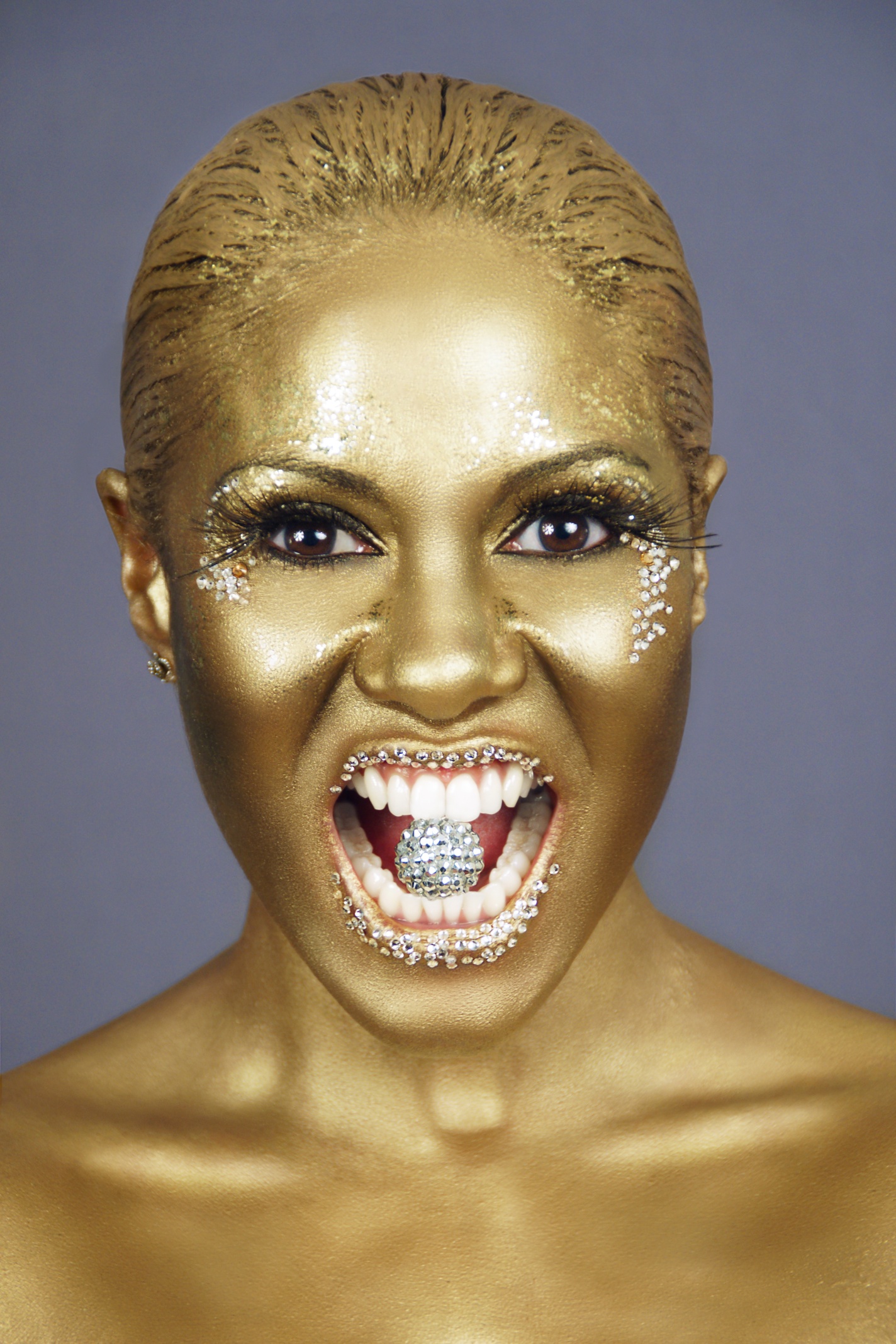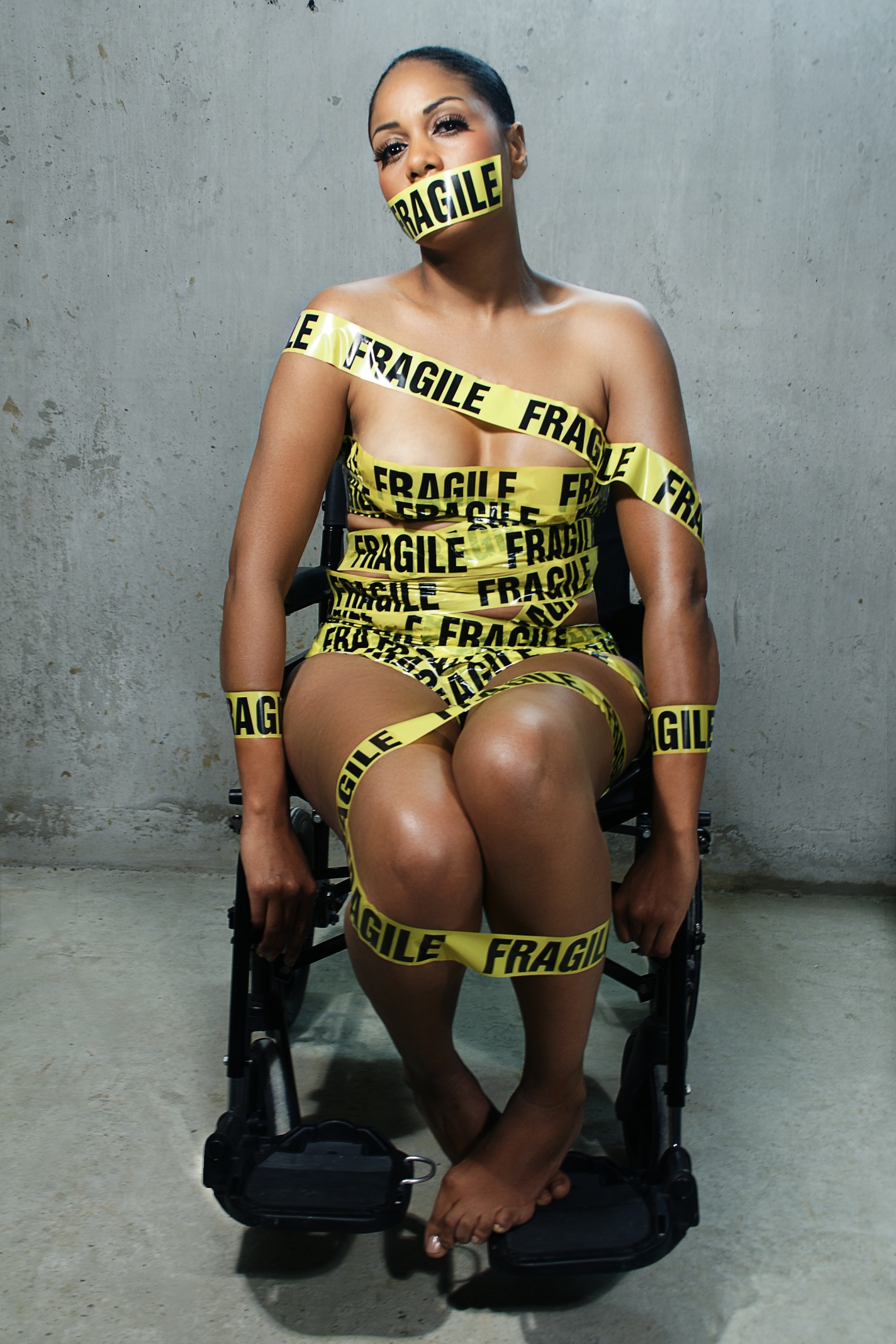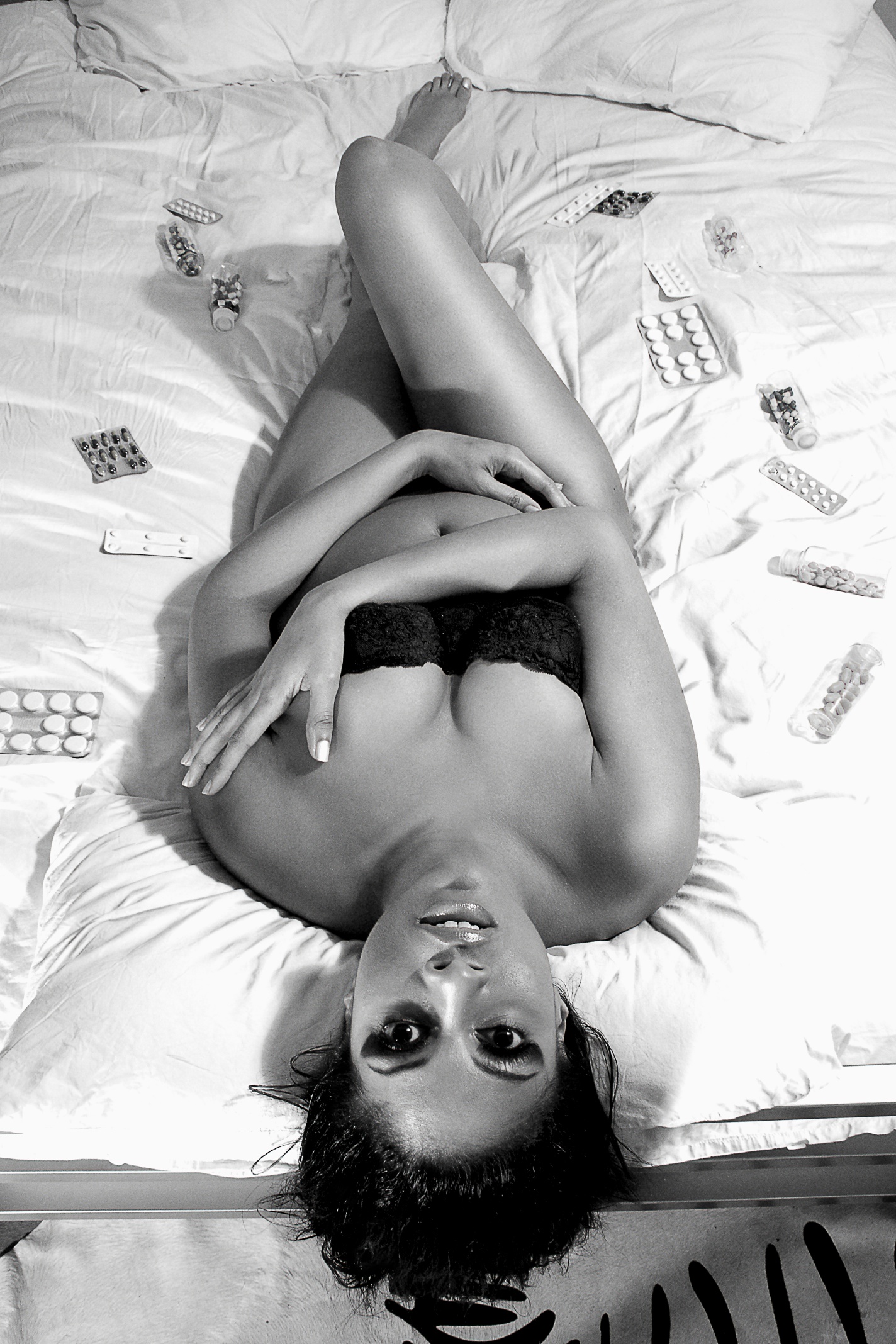
Huge lashes sweeping over her eyelids, face framed by diamante and skin shining gold, this is a photographic portrayal of how Samona Naomi Williams feels some days: valuable, not a burden to society.
Yet Samona, a wheelchair user who Ehlers-Danlos syndrome (EDS) type 3 which, amongst other things, affects her mobility, also has days where she feels trapped by her condition, vulnerable and delicate. Outwardly, on some days, she may show little sign of her disability. This is reflected in a portrait where she is bound to her chair with tape emblazoned with the word ‘fragile’.

Then there are times, she recalls, referring to a shot of her on a mattress strewn with medication, that her bed is a “marshmallow prison”: “There is no rest for me here. Yet I’m tied to it. I’m bound to it. There’s nothing sexy about being bed bound, though I wish to see it differently.”

Samona has turned her experience of disability into an art project, Bound, documenting her story with photographer friend Anthony David King. The pair recently exhibited the works at the Brick Gallery in east London and the pieces are available to view online at Saatchi with an exhibition tour of London planned for later this year.
Until her diagnosis in 2009, Samona was a TV, music video and film producer, producing and directing a short film screened at Cannes. With her condition, she felt she had “nothing to give”: “I was just this ‘disabled person’. I cannot write, I cannot do my films, I cannot work – that’s when Anthony and I sat down and had a discussion about what can I do to use to use my skills and illness. We came up with photographic project which we could make work around my disability.”
Anthony, who met Samona as a student, adds: “When she became ill, the impact on me as a friend, seeing her go through this…I could see she felt she didn’t have much to offer. We decided to do something together, an opportunity to do something not just for her but to tell her story that may be encouraging to others, looking at ways we could express her experiences.”
Samona’s condition means that everyday tasks – taking a shower or making a cup of tea – can be difficult. She uses a wheelchair when she goes out due to weakness, dizziness, a heart condition and pain when she walks. She often suffers fortnight long “crashes” where she remains in bed, exhausted and in pain. She describes these episodes as “being crushed by bricks”.
Yet the images are bold and provocative – Bed and Gold, for example, portray an attractive woman. Samona adds: “I may be sitting there [in bed or in the wheelchair], but in my head, I’m imagining something else, a feeling of fantasty. I was keen to get away from any stereotypical views that are out there; this is something that we don’t talk about – I’m still a woman…I know lot of people living with illness and we can infiltrate popular culture and can present beautiful images.
“Disability in the media is about benefit culture, it’s a negative thing, and also a lot of the time I feel people [without disabilities] cannot relate to disabled people, they have one of two reactions – they look away or they overcompensate. But we are just normal people who have an illness – it does not change you as person. I can’t get up every morning and do my hair but it doesn’t take away the desire to be who I am and who I was before. We all suffer from some kind of weakness and vulnerability; some wear it on the outside and some on the inside.”
The project, says Samona, also stemmed from a desire to draw attention to the lack of support for disabled people and how the current welfare reforms are a threat to vulnerable people.
Samona, who has home care, adds: “It is important, especially after the Paralympics, to keep attention on disability – not say ‘well, the Paralympics was a positive thing, and now let’s move on’…we are not miserable people who don’t want to work and who are in chairs and who are a burden on society.” She worries about the government cuts. “Of course they pick on the most vulnerable members of society, most disabled people are suffering.. it’s difficult to get out of bed some days, let alone write a letter to make a complaint. They kick you while you’re down.”
The artists stress that their exhibition portrays the the challenging side of Samona’s experience, but has a positive message. “The full set of images we shot try to keep a balance of reality – so the truth is that there are great moments and we tried to show that in images like Gold, Samona still has something to offer, still a valuable person,” says Anthony.
Samona explains the story behind the shots above:
Gold:
“When I realised that I wasn’t going to recover easily, quickly or perhaps not at all from this illness, I didn’t know what to do. I had so many dreams and goals and suddenly it felt as if I would no longer be an asset to this world. I was going to be a burden. A burden to my family, a burden to society, incapable of contributing anything to anyone. I sat and contemplated this new existence, I felt completely worthless and couldn’t really see the point of carrying on, I may as well end it, I thought. However the caterpillar struggles through its cocoon before it can become a butterfly and a rock undergoes immense pressure before it becomes a diamond. I slowly began to see this illness as less of a torment and more of a metamorphosis, a struggle into something greater than I was before. I saw my worth in a different way. I could still contribute to my family and I still have so much to give to society. How? By allowing myself to be me regardless of this illness and realising that rather than being worthless, I am worth more than ever before. I am valuable. I can still shine and I will still go on.”
Fragile:
“I sometimes wish I were wearing this fragile warning tape when I go out in the wheelchair so that people would heed the signage and treat me delicately. Being in a wheelchair means you are exposed and on show and people often have reactions, judgments and lack consideration. They may see you as an inconvenience or worst still behave like they don’t see you in a clumsy and nervous fashion. In my case, people behave confused ‘what exactly is wrong with her’. I see their questioning and it feels almost accusing sometimes, ‘You’re not really disabled.’ ‘You don’t look ill’. Imagine how that makes me feel. The physical pain is enough but this is coupled with emotional pain whenever I go out. I feel the need to explain, ‘Hey, I might look ok but I’m suffering every day’. I am broken physically and mentally and I wish people would understand. It would be easier if I could just wear the tape.”
Bed:
“I have found a new relationship with my bed. It’s like a marshmallow prison, necessary, uncomfortable, restricting and binding. It’s where I spend most of my time, in complete agony and pain. I feel restless, unable to sleep and too weak to stay awake. It’s a mind- numbing, agonizing, maddening experience being unable to move from the bed. Despite its billows of softness, feathered stage and relaxing countenance, it is not the pleasure pen that I wish it could be. There is no rest for me here. Yet I’m tied to it. I’m bound to it. There’s nothing sexy about being bed bound, though I wish to see it differently.”
* See the Bound website for more information or find Anthony and Samona on Twitter
